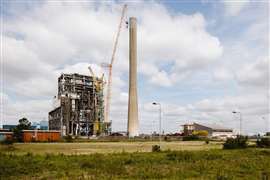Infrastructure investment
27 February 2008
![]()
Global construction activity is flourishing across the world and a great deal of the work has taken place in developing regions such as Africa, Asia, Latin America and in the Middle East. Large-scale construction projects are now being completed quickly in these regions because these structures are key to improving national wealth. Dubai in particular has been an attractive investment location and the number of multi–billion dollar construction projects taking place in the country, including the Burj Dubai – the world's tallest tower, has escalated. It has now been revealed that the country plans to spend US$ 11 billion on a waterway longer than the Panama Canal, the largest construction project undertaken in the emirate. Meanwhile, large-scale projects are still evolving in more developed countries such as the US and across Europe.
Tallest tower
One of the world's most iconic high–rise structures to have been constructed in recent times is the Burj Dubai, which when completed at the end of the year, will be the highest building in the world – expected to reach more than 800 m. However, that title could be under threat from a new proposal to build an even taller tower in the Middle East. Putzmeister had the task of supplying and installing concrete pumps and boom systems on the Burj Dubai. Preliminary tests on the tower revealed the pumps and pipelines were suitable for delivery heights up to 570 m with a pump output of around 30 m3/h. Truck–mounted concrete pumps with different boom reaches produced the base plate for the tower and the three tower wings. The 7000 m2 foundation is supported by 200, 1.5 m–diameter concrete piles, running 50 m deep for the tower, and on around 650 platform piles (cross section 0.9 m) running 36 m deep for the wings. In total, 45000 m3 of concrete was laid at the Burj Dubai for the foundation, including base plate.
Unimix, responsible for concrete production and delivery at the Burj Dubai, combined two super high pressure Putzmeister BSA 14000 SHP–D pumps and the 'normal' BSA 14000 HP–D high pressure concrete pump from the test phase to form one pump station.
A spokesman said, “Developing efficient concrete pumping for the spectacular delivery height at the Burj Dubai was just one of the many tasks for Putzmeister engineers. A particular challenge was the delivery line system, its wear behaviour and its compressive strength as well as the line routing and mounting in the structure.” A stationary Putzmeister standard concrete pump with standard delivery line was used for gradual concrete placement in the decks.
Challenging construction
Construction projects at great heights offer many challenges including restricted working space. However, Perini subcontractor, Aluma, claims that falsework and formwork such as its advanced column–hung system – Aluma Hi–Flyer – overcomes the challenge of ground space issues. The company is using the system for the formwork development at MGM/Mirages' new mixed use CityCenter project in Las Vegas in the US. According to the company, CityCenter is the largest privately funded project in the country at an estimated cost of US$ 7.5 billion. The 31 hectare project will establish a complete vertical city directly on the Las Vegas Strip between the Monte Carlo and Bellagio resorts. The development combines about 2700 private residences, two 400–room non–gaming boutique hotels (one of which will be managed by luxury hotelier Mandarin Oriental), a 60–storey, 4000–room resort casino, and a 43680 m2 retail and entertainment district.
Bridge links
High–rise buildings and large mixed–use structures are not the only impressive construction projects to have evolved in recent years – even bigger and better bridge developments can also be seen around the globe. An example is the 2 km Geo Geum II bridge in Korea, which was constructed with the help of automatic climbing system (ACS) formwork from Peri. The system helped construct four 168 m–high pylons for two cable–stayed bridges which connect the island of Geo Geum to the mainland – via Sorok Island – in the south–eastern part of the country.
A spokesman for Peri said, “Due to the off–shore location very high wind loads along with limited storage and assembly areas has to be taken into consideration in addition to the concreting loads.”
Meanwhile, to the south of Mumbai in India, construction work is taking place on the Bandra–Worli Sealink bridge project. Two V–A–shaped, four–legged pylons will be constructed for the main bridge. Joint–venture contractors, Hindustan Construction and China Harbour Construction, are forming the 129 m–tall towers using Top 50 large–area formwork raised by 48 Doka SKE 100 self–climbing units. The four smaller towers of the adjacent cable–stayed bridges are being constructed with SKE 100 units.
The bridge project is part of the construction of a 40 km urban motorway which comprises two identical cable–stayed bridges: a 150 m long bridge over the Worli Channel, and the main bridge, with a 500 m main span, over the Bandra Channel.
Speaking about the SKE 100 system, a spokesman for Doka said, “Its great adaptability to varying cross–sections and angles of inclination ensure a smooth, economical construction workflow.”
He added the system has several different platform levels, permitting the reinforcement steel to be placed a casting section ahead of the pouring operations.
“Its wide working platforms, enclosed on all sides, and the fact that the climbing scaffold is anchored to the concrete at all times, together ensure a very maximum of on–site safety – even when high wind speeds are encountered,” the spokesman said.
Dynamic dams
A host of new dam projects have also been developing across the world due to increasing investment in global energy resources. An example of this can be seen in the Nam Theun 2 (NT2) project in Laos, where Dynapac roller compactors are working on one of the world's largest hydroelectric schemes.
Dynapac CC422 and CC421 articulated tandem rollers and two CC102 steel–and–rubber drum units are in operation on the dam crest. Meanwhile, two Dynapac CA252D compactors are being used to grade, compact and maintain the earth surface of the roads around the saddle dams. A third CA252D is working at Thakhek, the border town with Thailand on the banks of the Mekong River, where a substation transformer will be located.
A spokesman for Dynapac said, “Nam Theun 2 is the largest foreign investment project ever undertaken in Laos and is being undertaken as a venture with neighbouring Thailand, which will buy 95% of its electricity supplies, with the remainder being used domestically.”
At a cost of US$ 1.25 billion, NT2 is also the world's largest private sector cross–border power project, which is due for completion in late 2009. The dam is being built as a 39 m high, 436 m long concrete gravity structure that, along with 13 smaller earth saddle dams across various other valleys, will create a 450 km2 reservoir, flooding the Nakai Plateau.
Elsewhere, two 3412 HT Hamm vibratory compactors have been working on an embankment dam at the foot of the Andes in the valley of the Rio Blanco in Chile. The machines have been compacting some 7400 m3 of sand every day for three years.
A spokesman for Hamm said, “The structure is the southern boundary of the 5 km2 reservoir in Ovejería, near to the town Til–Til. Here, the Chilean company Minería y Montajes Con–Pax is constructing a gigantic dam, almost 3 km long, and made almost entirely out of sand.”
The spokesman said some 72000 tonnes of ore are mined every day and 95% of it ends up in the reservoir in the form of slag.
“The construction of the dam will considerably increase the capacity of the natural reservoir: once the dam has been completed, the volume of the reservoir will be large enough to accommodate the slag for the next 50 years,” the spokesman added.
Outlook
Completing large structures is now performed at a quicker pace and is a reflection, particularly in developing countries, of the need to improve infrastructure for purposes of international and national trade links. The construction of new roads, bridges, tunnels, runways and dams breathe new life into underdeveloped regions of the world and strengthen economic opportunities.
STAY CONNECTED


Receive the information you need when you need it through our world-leading magazines, newsletters and daily briefings.
CONNECT WITH THE TEAM










